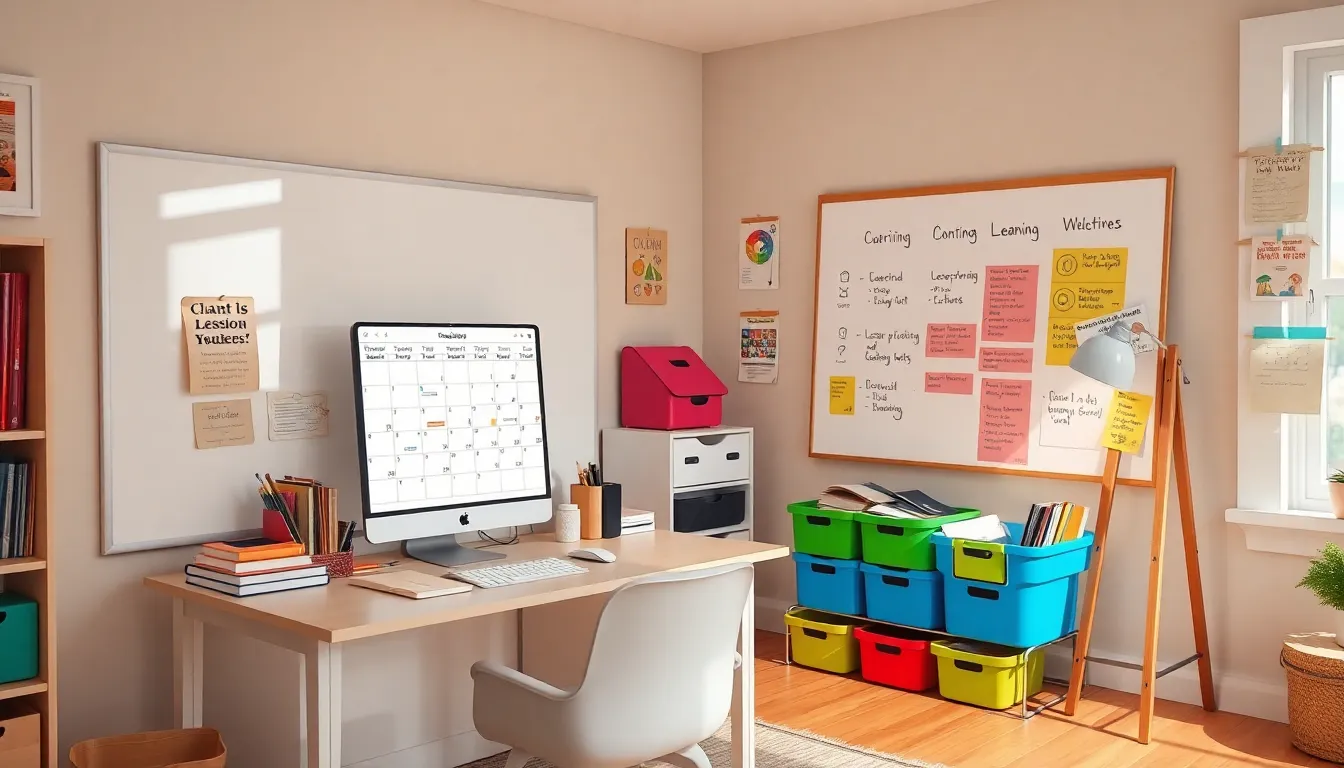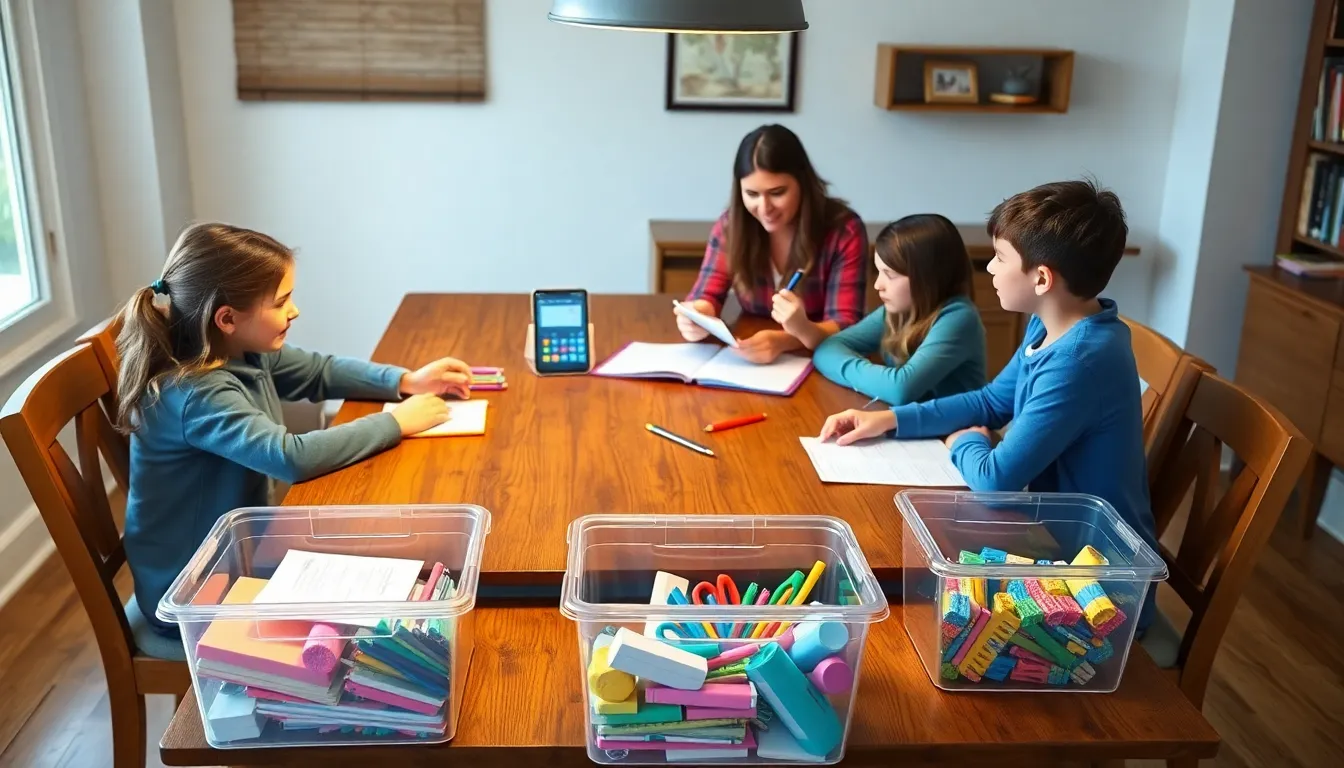Home school organization might sound like an oxymoron, but it’s the secret sauce to turning chaos into calm. Imagine a world where textbooks don’t double as coasters and art supplies don’t mysteriously vanish into the Bermuda Triangle of your living room. With the right strategies, parents can transform their homes into efficient learning hubs that rival any classroom.
Table of Contents
ToggleUnderstanding Home School Organization
Home school organization plays a crucial role in fostering productive learning environments. Proper organization not only minimizes chaos but also enhances the educational experience for students.
Benefits of Home School Organization
Improved focus and concentration stem from an organized study area. Access to materials becomes seamless when everything is in its designated place. Structured schedules promote consistent learning habits. Clarity regarding tasks helps children understand expectations. Reduced clutter creates a calming atmosphere conducive to studying. Increased productivity results from having less time spent searching for supplies or textbooks. Positive emotional health also emerges, as children feel more confident in their abilities.
Common Challenges
Disorganization remains one of the most significant challenges in home schooling. Parents often struggle with maintaining order amid daily distractions. Finding adequate space for materials can prove difficult in small homes. Balancing multiple subjects requires careful planning and attention. Changes in family schedules might disrupt established routines. Children’s varying learning styles add complexity, necessitating adaptable organizational strategies. Frequent interruptions, caused by other family activities, can further complicate the organization process.
Essential Tools for Home School Organization


Effective organization relies on utilizing the right tools. Various options exist to create a structured learning environment at home.
Scheduling Tools
Scheduling tools play a crucial role in maintaining a consistent routine. Digital calendars offer reminders for assignments and deadlines. Planning apps allow families to map out weekly lessons and activities. Whiteboards serve as visual aids to highlight daily objectives. When schedules are clear, students better understand expectations and stay focused. Sharing schedules with all family members fosters accountability and enhances cooperation.
Storage Solutions
Storage solutions significantly impact the organization of homeschooling materials. Clear bins provide visibility for supplies and textbooks, making it easy to locate items quickly. Shelving units optimize space, allowing for designated areas based on subject or activity. Labeling containers ensures everyone knows where items belong. Sticky notes or hanging organizers can store frequently used materials, promoting easy access. When everything has a place, learning spaces remain tidy and efficient.
Effective Strategies for Home School Organization
Creating an organized learning environment enhances the homeschooling experience. Implementing effective strategies helps streamline the process.
Creating a Dedicated Learning Space
Designating a specific area for learning boosts focus and minimizes distractions. This space should be equipped with essential materials like textbooks, art supplies, and any technological devices. Clear bins for supplies, shelves for books, and a designated workspace contribute to an orderly environment. Personal touches, such as student artwork, can motivate children and make the space inviting. Consistency in this area nurtures a mindset conducive to learning.
Implementing Routine and Structure
Establishing a daily routine provides a solid framework for education. Set consistent start and end times to create predictability. Break the schedule into manageable segments, allocating specific times for each subject and including short breaks. Using visual schedules allows children to track their progress easily. Flexibility in this structure accommodates different learning styles, ensuring engagement. Regular check-ins help monitor understanding and adjust the approach as needed, promoting accountability and focus.
Involving Your Family in Home School Organization
Involving family members in home school organization boosts efficiency and enhances the learning experience. Family participation creates a sense of community that encourages success.
Roles and Responsibilities
Assigning specific roles helps streamline tasks. Parents can ensure planning and material selection while children take on responsibilities like organizing their study area. Each family member contributes to the overall environment. Clearly defined duties encourage accountability and provide structure. For example, one child may manage art supplies while another keeps track of textbooks and assignments. With this collaborative framework, everyone understands their contributions towards effective home school organization.
Encouraging Collaboration
Collaboration fosters a supportive learning atmosphere. Weekly family meetings can facilitate discussions about progress and challenges. Engaging children in decision-making strengthens their investment in their education. They may help develop a schedule that suits their learning pace. Group projects serve as an excellent way to promote teamwork while reinforcing subject concepts. Additionally, sharing accomplishments reinforces family bonds and motivates everyone to stay committed to the home school journey.
Home school organization is essential for creating a productive learning environment. By implementing effective strategies and utilizing the right tools, families can transform their homes into structured spaces that promote focus and accountability.
Engaging all family members in the organization process fosters a sense of community and shared responsibility. This collaborative approach not only streamlines tasks but also enhances the overall educational experience.
With a well-organized setup, parents can better support their children’s learning styles while minimizing distractions. Ultimately, a dedicated and organized home school environment lays the foundation for successful and enjoyable learning journeys.













